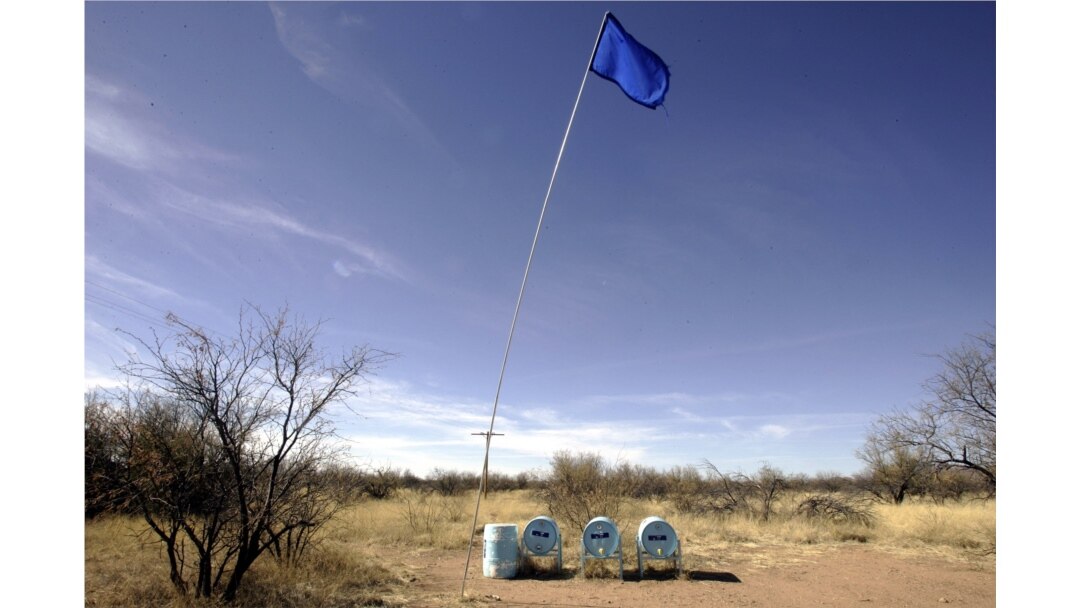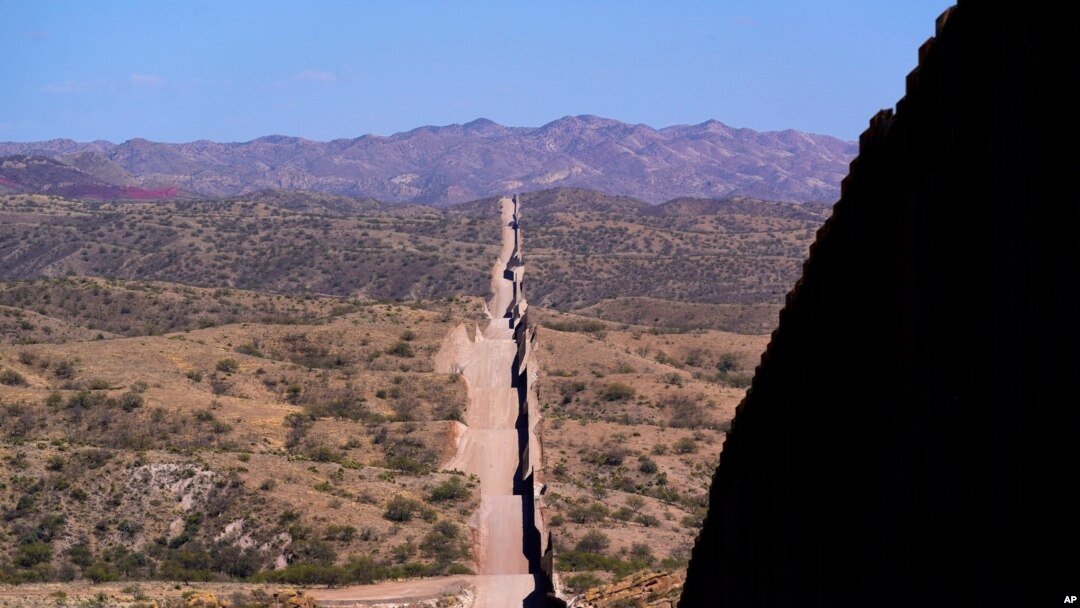Record-setting migration to the U.S.-Mexico border and scorching heat waves are contributing to an especially deadly summer for migrants negotiating desolate and unforgiving desert terrain in hopes of reaching the United States.
In June alone, the remains of 43 bodies were found in Arizona's Sonoran Desert north of the U.S. border with Mexico, according to the Tucson-based nonprofit group Humane Borders. The group tracks the recovery of bodies along one stretch of the 3,145-kilometer border, using data from a medical examiner's office.
"What is happening is climate change is real, and the temperatures have been getting hotter and the weather itself is more volatile," said Brad Jones, a volunteer with Humane Borders.

Water tanks from the NGO Humane Borders are placed in the desert as supply for immigrants crossing the area near Arivaca, Arizona, March 23, 2006.
The group has documented remains found in the U.S. as far as 40 kilometers from the border and noticed increased traffic in the remote western desert, where migrants are cut off from almost any form of emergency assistance.
The National Weather Service reported that June was the hottest month on record in the Phoenix and Tucson areas of Arizona, with temperatures regularly above 43 C (110 F).
Jones said June is often the hottest month of the year in the border region. He noted that June's migrant death toll in Arizona was tragically high but not atypical.
"In other words, there's been a migrant death crisis on our border right at your doorstep for 20 years. And in the Arizona-Mexico borderlands itself, nearly 4,000 people have lost their lives over the last 20 years. On average, about every two days migrants' remains are found," he said.
A U.S. immigration official told VOA that federal data compiled on migrant deaths might be lower than the collective total recorded by coroner's offices in counties along the border. However, federal authorities have documented that the remains of 324 migrants have been found along the border so far in the 2021 fiscal year, which began in October.
A U.S. Customs and Border Protection (CBP) spokesperson said that terrain along the border is extreme, the summer heat is severe, and the kilometers of desert migrants must traverse after crossing the border are unforgiving in many areas.
"CBP's message for anyone who is thinking of entering the United States illegally along the Southern border is simple: don't do it. When migrants cross the border illegally, they put their lives in peril," the spokesperson wrote in an email to VOA.
While dangers have always abounded in the border region — including drowning in the Rio Grande, for those crossing from Mexico into Texas — researchers have seen a rise in migrant deaths caused by heat and exposure.
Heat is blamed for most migrant deaths recorded by the Pima County medical examiner's office in Arizona, according to Sam Chambers, a geospatial scientist at The University of Arizona's Binational Migration Institute.
Chambers studies the impact of stricter U.S. border enforcement, which has caused migrants to resort to trekking through more remote areas of the Sonoran Desert to reach the United States.
Chambers notes there are extreme perils, even for those who opt to traverse mountainous areas where shade is more abundant and the heat less extreme.
"Because of the funnel effect (of border enforcement) and people having to move longer distances, they are less likely to have (adequate) water. They have perspired all the water and they can only carry so much," Chambers told VOA. "And even if more people are moving into these more hospitable areas, because of factors like dehydration, they can still succumb to heat-related deaths due to their bodies no longer being able to regulate the temperature because of lack of water."
Still, most migrants' remains are found in low desert areas that broil with ever-hotter temperatures.
According to data compiled by Chambers, migrants who perished were overwhelmingly male and usually between 20 and 49 years of age. Roughly 80% were from Mexico.
Water is left by volunteers of the nonprofit Border Angels in a remote area of the mountains near the end of the fence at the U.S.-Mexico border, in Tecate, California, on Dec. 29, 2018.
Humanitarian groups working along the border believe the actual migrant death toll is much higher than what has been officially reported over the years, with some bodies never found.
Border Angels, a nonprofit organization in San Diego, California, that supports more than 15 shelters in Tijuana, Mexico, estimates that over the past 27 years, more than 11,000 migrants have perished in their attempt to cross the southern border.
"But we will never know for sure," said Border Angels Executive Director Dulce Garcia.
Garcia said the group is seeing more migrants who have been waiting years to present themselves at a U.S. port of entry and ask for humanitarian relief.
"These people that are here waiting, they're very desperate. And even in 120-degree (Fahrenheit) weather (49 C), even when they know they're risking their lives, the alternative is remaining in a country (Mexico) that also is a risk to them and their lives. So they feel like they have no other choice but attempt to cross into a country that they think is going to be safe for them," Garcia told VOA.
The U.S. Border Patrol has reported more than 7,000 migrant deaths along the U.S.-Mexico border from 1998 through 2020, according to archived data.
Water drop programs
Border Angels operates what's known as a water drop program. For roughly 20 years, volunteers have been depositing as much water as they can along the desert paths most traveled by migrants.
In 2020, they placed more than 4,000 liters of water with messages written in Spanish: "Te deseo suerte," or "I wish you luck."
Garcia said volunteers are careful to follow the law and keep interaction with any migrants they encounter to a minimum. But if someone is in distress, they call 911 for emergency assistance.
"We don't assist anyone in the crossing. We only drop supplies to make sure that people don't die," she added.
Humane Borders has its own water program, and Jones said there are dangers associated with doing work as simple as giving out water.
"It has to do with a number of hate groups and racist terrorist groups that roam the desert and are actively seeking to disrupt humanitarian supplies," Jones said. That is one of the reasons his organization does not advertise water drop locations, he added.
If Humane Borders' volunteers find human remains during their water drop runs, Jones said, they immediately contact the U.S. Border Patrol.
Looking at the latest information on post-mortem interval — the time that has elapsed since an individual's death — for those found in the month of June, Jones said most died within the previous 30 days.
"So, it's not like these are a bunch of skeletal remains that just happened to be found. These are real, living, breathing people who in May were alive and, by the end of June, were not alive anymore," he said.


